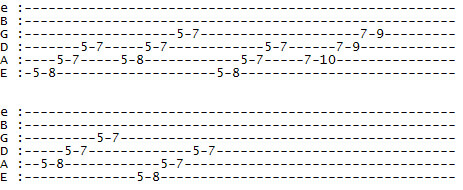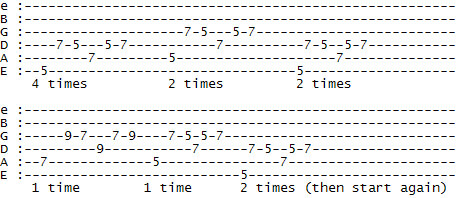
|
Guitar
Lesson: Riff Building Using a Three Scale Progression
By
Scott Morris of www.guitartabbooks.com
Post
your comments or questions here
Welcome to our first guitar lesson from Billboard Magazine's
top rated instructor, Scott Morris. This first lesson will
focus on riff building using a three scale progression. The
first thing to learn is the scale below, a Pentatonic Minor.
Pent means five and tonic means notes so basically, you will
be playing a five note scale. The notes in the A Pentatonic
scale are A, C, D, E, G, then ending back with A note (one
octave higher). Begin by slowly learning this scale. If your
new at learning Tablature, a quick easy explanation is; the
lines = strings, the numbers on the lines = frets, the smallest
string or high e string is represented by the line on top
with a small e and the largest string or low E string is represented
by the line at the bottom with a large E. Ready? Lets begin.
A
Pentatonic Minor Scale

Practice
this a few times, before moving on.
Shown
below are the three scales that we'll be working with throughout
this lesson. You'll find the names of the notes beneath each
scale. A good student will focus during the course of this
lesson by also trying to remember the names of the notes.
Now, go ahead and give these next three a try. A Pentatonic
Minor Scale, D Pentatonic Minor Scale and E Pentatonic Minor
Scale.

Next, we will play these scales as a three scale progression.
After playing through this a few times, it will clearly demonstrate
in sound how three scale progression is the format used by
many famous blues artist when creating riffs when writing
a song.

RIFF
BUILDING
A riff is a series of notes taken from a scale that may be
used to create a rhythm or melody of a song. This next example
clearly demonstrates how this riff was created by taking notes
from the A scale. After you try this riff a few times and
get used to it, we will then put this riff in order as we
did practicing the three scale progression, which will demonstrate
how you can create riffs from scales to build rhythm parts
to create a song.

OK,
now that you have the basic idea, lets play these riffs in
order as we did with the three scale progression. By now you
should recognize each riff by it's scale name. For example
the A scale riff, The D scale riff, and the E scale riff.

Well
students, that will complete this lesson. I hope this helped
give you a better idea of scales and how scales are used to
build riffs and create rhythm parts for songs. In our next
lesson I will be showing you the formula for a major scale
by using whole steps and half steps. I'll be mainly focusing
on the key of C major as there are no sharps and flats which
will make it easier for you to understand, as the notes in
C major scale are C,D,E,F,G,A,B,C. I will also demonstrate
how this scale was used for creating some of the most famous
riffs in History, from Star Wars to Walking Bass lines, applicable
for all guitar and bass guitarist.
In future lessons I will be teaching you many different elements
of guitar playing from Blues Scales, Diatonic Scales, Scale
Formulas, Chord Formulas, Ascending and Descending Runs, Bar
Chords, Power Chords, The Gypsy Scale, The Diminished Scale
and Run, Guitar Licks, Fingertapping, Whammy bar Tricks and
much more. I will also give information on special effects
and equipment. Until then, today's lesson tip is: "He
who practices most, plays best!"
So until next time.....
Scott Morris
youcanplayguitar@core.com
Author/Publisher of You Can Play Guitar Videos and Metal Rock
Tab Books
If you have any questions about this lesson, feel free to
Email me. As a guitar student of OnlineRock you can receive
a 10% discount on all guitar lesson videos and tab books by
Billboard's top rated instructor, Scott Morris, author and
web host of You Can Play Guitar. Visit the Web site at www.guitartabbooks.com
|
|
 |